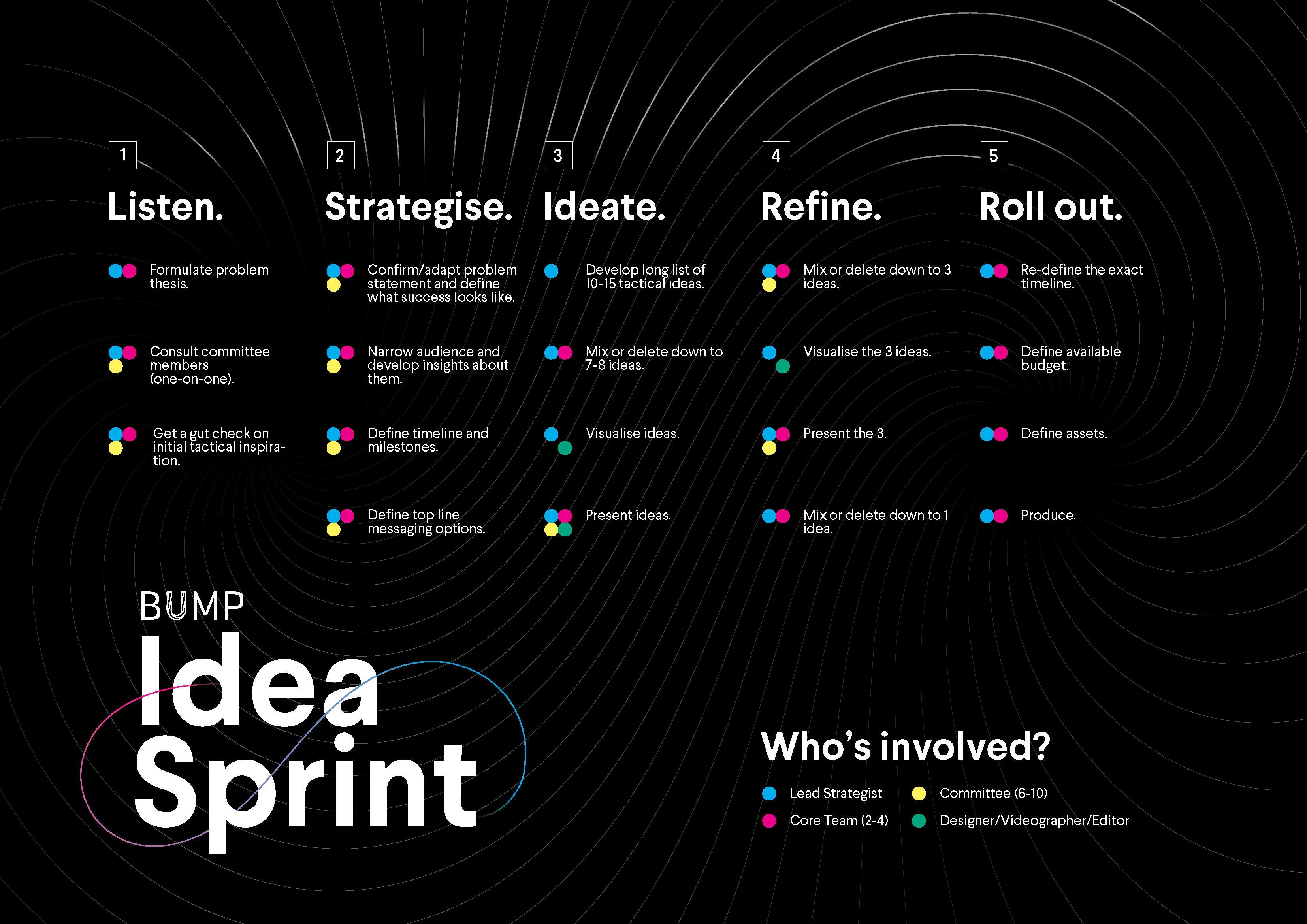How can we build a process to co-create ideas that reflects the complex reality of getting people on the same page?
They’re brilliant people really, with tonnes of excellent ideas. We’re talking about public affairs pros, communicators and marketers of course.
But for better or worse, having great ideas in isolation is not enough. The reality for those really brilliant people is that they typically need to bring others along with them on the journey to building and executing ideas that solve problems.
That group of others can range widely in composition – from colleagues inside the same organisation who differ in specialism and seniority to external parties like competing companies in the same industry or NGO partners. All of these diverse individuals bring unique perspectives but also present unique challenges when it comes to directing their energy towards a common objective.
After co-creating in this way with nearly 40 clients over three years, the Bump team has collected our learnings into the Idea Sprint – a clear framework for bringing people together to build great ideas.
We use some variation of this for EVERY client collaboration we undertake, but also encourage clients (and everyone else for that matter!) to use it as well.

Below you’ll find a quick overview of how to think about the Idea Sprint and how it works in general terms. Does this account for every minute of the process and explain every possible pivot? Every variation? Definitely not, that would be a very long post haha. But the flow works, trust us.
Here’s are the roles typically assigned in a Bump Idea Sprint:
Find the right way to get face time with your committee members. Ask them a few leading questions but mostly just listen.
Our preferred method of listening to a large committee is to first share a short survey (loving TypeForm for this) to get a baseline for their thoughts and then follow up with an individual call or meeting for them to elaborate verbally on those thoughts.
Important Qs to ask:
Equipped with the group’s input, it’s now time to synthesize it into a strategy. You’ll want to playback some version of the Qs in the last step. We recommended you include a few options in here to reflect what you heard.
For example, “3/5 of the group said we should do X, 1/5 said Y and the remaining 1/5 said we absolutely should not do X or Y, but rather Z”
As part of this exercise don’t forget your target audience – pull together as much research as you can about them and hypothesise what might get them to move (or form a POV on whether they can be moved at all). If (like in most of our collabs) your audience is very niche, be honest about how much “research” you can actually do and don’t overspend time trying to reach a likely unachievable level of granular insight on what makes them tick.
Smash together the strategy options with the audience insights to craft a top line message for each strategy option. Imagine that this is the one sentence you’d be able to speak to your audience to tell them what you want them to do and why they should do it.
Here’s where it gets really fun. It’s time to take each of those top line messages and think about tactical ways to bring them to life. The list of possible tactics are infinite, but here are a few easy prompts we like to get brains moving:
Take your message and ask yourself how would I:
Start with a long list of ideas, which ideally you build together with your core team. Then narrow them down to a shorter list and visualise them.
Ok, you’ve been busy (!) and now’s a great time to go back to your committee. Book at least an hour (two is better to give the process weight) with the whole group together and show them step-by-step in a slide deck how you got to where you are. If you’ve listened well and presented clearly, each committee member will see their thoughts reflected explicitly in your process – the ideas you are showing are ALREADY their ideas.
Run them through some exercises to get feedback to narrow the field of ideas. Your goal here is to discard a few entirely the mix and match a few.
Come back to the group with your idea now at 85% (don’t forget to explain AGAIN how you got there, people have short memories) and get their feedback on what the remaining 15% should look like.
Get granular now on tactics and timings. Put the full 97% on paper (allowing 3% for tiny adaptations for the latecomer committee member who could blow everything up unless you make clear exactly how much margin for maneuver is left) and make the preparations to bring this beautifully co-created idea to life.
In a few cases, we’ve managed to run this whole process in about two weeks and ideally, you want to move through it as quickly as possibly to keep momentum. It’s more likely that you’ll need three to six weeks, but be careful: allowing the process to stall between steps or last beyond the six-week timeframe can allow your group to lose focus and change their minds about every step they’ve completed.
Literally everything you see on our website (and more) has involved some variation of the Idea Sprint. Co-creation, every dang time. It’s really the only way we work:)
Good news. So are we.